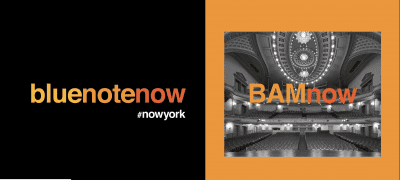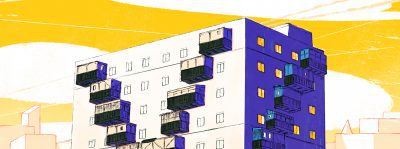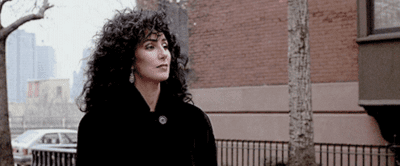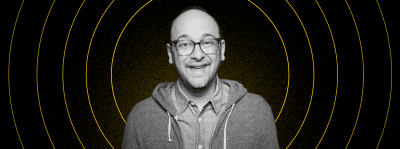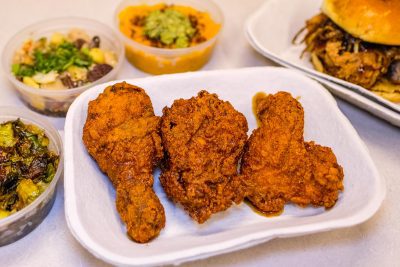Tailored Industry's factory floor at Industry City (Audrey Fromson)
Six Brooklyn creatives printing (and knitting) life in 3D
From swimsuits to PPE gear, these entrepreneurs are tapping the new tech in innovative ways
Chances are, at some point this summer, you’ve grabbed a ketchup or mustard bottle and squeezed condiment ribbons into designs on your hotdog or hamburger. If so, you’re more cutting edge than you might have realized: 3D printers and knitting machines essentially work in the same manner, only with spirals of filament or yarn.
And, as it happens, there is no shortage of creators printing life in 3D across the borough. From swimwear to home lighting to PPE gear, here are six Brooklyn-based businesses — Makelab, W00j, Capture it in 3D, Deta, 3D Brooklyn and Tailored Industry — using 3D printing and knitting technology to transform the way we make, get and use our stuff.
Tailored Industry
Knitting used to be big business in Brooklyn. Alex Tschopp, co-founder and CEO of Tailored Industry in 2017, honors that history from his shop in Sunset Park’s Industry City.
Rows of 3D knitting machines line Tailored Industry’s factory floor. But unlike traditional knitting machines that use two needle beds, the Japanese Shima Seiki machines at Tailored Industry use four. 3D knitting machines create garments in one piece, which means there is no need to sew panels together or cut fabric apart.
View this post on Instagram
Whereas the fashion industry currently relies on a mass production model that generates tons of waste, 3D knitting allows for a more personalized and less wasteful approach, according to Tschopp. The factory lets its 70-plus clients make what they want when they want (one client knits dog sweaters). Customers choose a subscription tier, which varies in terms of design features and shipping methods. In so doing, nothing goes unsold and nothing ends in a landfill. “We’re the only factory on the planet that is subscription-based and on-demand,” says Tschopp.
Tschopp and co-founder and chief operating officer Kady Gray oversee software engineers who design clients’ garments electronically and a post-production team that acts as quality control: They wash and steam every item and might sew on buttons or add an elastic on others. Being in Brooklyn allows clients to bypass weeks and often months of sending prototypes back and forth between the U.S. and overseas, sewing a cleaner way toward fast-slow fashion.
Deta
Deta is one of several companies using Tailored Industry’s machines for innovative work in its own right. Founder Anna Berger had formerly employed literal grannies in Berlin to knit for an earlier iteration of her knit swimwear line. Now she uses Tschopp’s 3D knitting machines here in Brooklyn.
Berger moved to Brooklyn from Berlin, while manufacturing her line in Los Angeles. She joined Pratt’s now-defunct Brooklyn Fashion and Design Accelerator where she fine-tuned her designs. There, in 2018, Deta was born.
She hadn’t been looking for a 3D printing factory but was thrilled when she learned about Tailored Industry from a mentor. “I have a German engineering brain,” says Berger. “I thought, this is so cool. 3D-printed swimwear doesn’t exist.” Outside of a publicist, Deta is a one-woman shop; Berger works with Tailored Industry’s in-house design team for additional support.
Not only was 3D knitting new to Berger, but it offered her the most sustainable production process she’d seen. “Yes, I’m making a new product, but the tradeoff is that there’s no inventory, and hardly any yarn is used,” says Berger, who knits with high-quality Japanese Polyester. “I make reasonable decisions with what I have.” While fast fashion companies release new styles weekly — and sometimes more frequently than that — Berger releases new collections annually. Even then, stylistic changes are often subtle ones.
View this post on Instagram
“I prefer to build upon what we already have rather than making something completely new.” Berger uses customer feedback to release new colors and enhance Deta’s three swim top styles, three versions of briefs, and a standout one piece design. Each item takes about 33 minutes to make. This method saves Berger money, time and waste that would be created in designing completely new suits.
Wooj
“I feel very affected by the objects around me,” says Sean Salgado, founder of Wooj, a 3D-printed home goods company. Wooj primarily focuses on the most key aspect of our spaces: lighting. “It has the power to shift your perspective of your surroundings.”
Wooj started with a single 3D printer in Salgado’s apartment closet. He and his small team now work with 20 printers out of their Bushwick studio. While Wooj could find cheaper rent elsewhere, Salgado has remained loyal to the borough. “Staying feels worth it. You get to engage with Brooklyn. It has such a storied history of design and art.”
A few times a year Wooj opens its doors to the community to sell “seconds,” products with small blemishes (like your unreliable home office printer, 3D printers also get it wrong sometimes). Customers flock to their signature fixture: the wiggly Wavy Lamp.
Time lapse videos of Wavy Lamps being printed are mesmerizing; the filament’s material, temperature and speed at which it’s fed through the printer’s nosel all affect a product’s appearance. Just as in 3D knitting, there’s an electronic ecosystem humming away behind the scenes. Salgado and his team code each product and work with prototypes to master their designs.
View this post on Instagram
While Salgado is focused on aesthetics, he’s equally preoccupied with sourcing. “We’re most concerned with what it looks like and where it comes from.” A lot of “it” comes from the ground. Recycled PHAs (Polyhydroxyalkanoates), for example, are corn-based plastics that feature heavily in Wooj designs. While PHAs are technically biodegradable, Salgado says there aren’t yet enough recycling plants in the U.S. that process this material. Still, Wooj’s materials are more eco-friendly than virgin plastics. Plus, they’re made-to-order: each piece is unique.
3D Brooklyn
It all started with garbage. In 2013, 3D Brooklyn’s Nate Kolbeck 3D-printed recycling bins made out of recycled plastic for his community. Two years later, he teamed up with Will Haude to form 3D Brooklyn. Their projects grew in scale, and within the first 10 weeks of the pandemic, the company paused regular programming as a design studio and printing house to crowdfund the printing of 15,000 reusable face shields.
Making PPE felt like the obvious choice, says Kolbeck. Running a “small and nimble” business allows for just such a pivot. “It came down to speed and flexibility.”
Once a client comes to the company with an idea, a team member heads to the computer to build out a prototype. Sometimes clients come ready with a file that just needs to be printed. In other instances, 3D Brooklyn will recommend another local printing studio if they think an item should be printed with a specific kind of material (clay, for example).
“Brooklyn is filled with creative people that keep our work interesting. We’re supported by a diverse network of local manufacturers. If we can’t make it, chances are we have somebody who can,” says Kolbeck.
Past projects at 3D Brooklyn have included everything from jewelry to trophies to shoe prototypes. “We have a love for the technology,” says Kolbeck. “What’s most important is bringing a client’s vision to life.”
View this post on Instagram
Like its counterparts on this list, 3D Brooklyn aims for sustainability. Their studio is equipped with a filament extruder, a machine that allows them to use a variety of materials to make printer filament. Their company is often hired for events where they turn the event waste (plastic cups or even potato chip bags, for example) into party favors.
Some of the bioplastic that 3D Brooklyn feeds into the extruder at their studio comes all the way from the U.K. There may be a demand for a sustainable alternative to new plastic, Kolbeck says, but the supply just isn’t where it needs to be. “There’s always a Catch-22.”
Makelab
You’ve likely heard of Quip toothbrushes or Billie razors. Behind the scenes, Brooklyn’s Makelab 3D prints the prototypes of these products, iterating on designs before they head to the factory.
Makelab was founded in 2017 by partners (in business and marriage) Christina Perla and Manny Mota, who share a background in industrial design: Perla has worked for a wearable tech design firm and Mota taught at the Pratt Institute.
Perla and Mota noticed a gap in the market for businesses that had product ideas but nowhere to quickly bring them from a computer screen to the 3D world. “We focus on 3D printing parts and developing prototypes,” Perla says. Once Makelab’s clients sign off on a final version of a product, molds are made for manufacturing at a large scale. These days, one of Makelab’s clients is Interwoven Design Group — the same wearable tech company Perla worked for. “It’s all very full-circle,” she says.
Makelab’s Downtown Brooklyn office is housed in a late 19th century building originally meant for a printing press. So it’s quite fitting that there are 36 3D printers here, creating designs with countless materials including castable wax resin for jewelry, and even soft elastic for gaskets and seals.
View this post on Instagram
Like the other companies profiled here, Makelab embraces sustainability but avoids “overpromising” on that front. While it’s true that many filaments might be considered biodegradable, Perla, like many of her counterparts, emphasizes that “greenwashing is a real problem in the industry” and that some “sustainable” materials take decades to break down.
Perla also points to a more serious problem in the industry: “We don’t print weapons.” While most people wanting to print firearms (or parts of them) turn to businesses who advertise this service or sell files that people can use to print weapons at home, Makelab has received and “rejected projects [like these] in the past.” It’s just not what they do. “We want to help other businesses,” Perla says.
Capture it in 3D
David Lynshue started his career as an engineer. “I was watching the news one morning,” he tells Brooklyn Magazine, “when I saw someone had printed a gun in their backyard.” Like the founders of Makelab, Lynshue didn’t have any interest in printing firearms. He was, however, curious about the tech behind the phenomenon. In 2015, he jumped back into the world of engineering, this time founding Capture it in 3D.
In its early days, the company focused on 3D scanning; they’d show up at comic or cosplay conventions and turn scans of attendees into 3D printed miniature figurines. “Printing miniatures was the coolest thing ever,” Lynshue says.
While 3D scanning carbon copies helped put Capture it in 3D on the map, it wasn’t very profitable. Today, the company mostly prints “manipulated,” or altered, 3D scans and focuses more on scanning as a mode of customization.
“3D printing is the main part of our project,” says Lynshue. And often, those designs are printed on a huge scale. Larger items are printed in Capture it in 3D’s New Jersey or Vietnam spaces, while smaller designs can be completed in their Greenpoint office. Lynshue’s Brooklyn team is roughly 10 strong.
View this post on Instagram
At the beginning of the business, Lynshue was working out of his home. But when an early “big” client wanted to meet at Capture it in 3D’s office, Lynshue knew it was time to find a studio space. Originally from Long Island, Lynshue decided to build his business in Greenpoint after a friend told him about the artistic underpinnings of the area. “
Capture it in 3D still prints small figurines — Lynshue has even scanned 50 Cent — and has more exciting large-scale projects down the pipeline. “It’s always something new.”
You might also like 

















